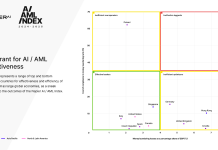A recent webinar by Alessa by Tier 1 Financial Solutions has examined what constitutes a politically exposed person (PEP) and why relationships with certain PEPs may offer increased financial crime threats.
The webinar – hosted by founder of Compliance Notes Ola Tucker – sought to provide an understand of when and how to conduct the appropriate amount of due diligence for PEP clients and why it is not always straightforward.
According to the Financial Action Task Force (FATF), a PEP is defined as an individual who is or has been entrusted with a prominent public function. Through their prominent position or influence, they are seen as more susceptible to being involved in bribery or corruption.
In the webinar, Tucker started, “By way of introduction, PEP status is not a definitive indicator of past, present or future criminal behaviour, but it does present additional risk exposure to financial institution.
“In fact, studies by the FATF and other international organisations have identified that positions held by paths are particularly vulnerable to abuse for purposes of corruption, money laundering (AML), and even terrorist financing.”
Due to this, Tucker recommended that financial institutions must apply additional AML and counter financing of terrorism when establishing a relationship with a PEP. She mentioned that besides initial customer due diligence and the development of a customer risk profile – something that should be done for all customers. Additional measurers for higher risk customer customers would include things such as enhanced due diligence, which is a more thorough review, and more frequent ongoing monitoring of that customer relationship.
Tucker added, “These measures are not meant to inhibit access to services but rather to mitigate risks presented to the financial institution by those customer relationships. In fact, regulators discourage de-risking, meaning terminating or declining to open accounts, or entire categories of customers proceed to present a higher AML risk.”
It was highlighted in the webinar that FinCEN (Financial Crimes Enforcement Network) and federal banking regulators had previously released a statement encouraging financial institutions to mitigate risks by implementing controls that are commensurate with such risks.
Despite this, Tucker emphasised that several other jurisdictions globally have released new regulators or revised guidance, and therefore it was important for companies to always follow the requirements in their local jurisdictions. However, she added that depending on the risk tolerance of a particular organisation, anyone entrusted with a public office may be considered a PEP, and also a number of authorities and regulators may sometimes apply different rules for domestic and foreign PEPs.
What risks do PEPs offer?
A key question for many organisations is why are PEPs considered high risk in the first place? According to Tucker, the reason that PEPs are considered to a present a higher money laundering risk and risks for involvement in financial crimes generally is due to the influence and power that they yield that stems from their dominant role or position.
Despite this, it is common to find that a majority of PEPs do not abuse their position and in reality, will not pose any additional risks. However, for those who do abuse their standing, it is almost always done through methods of concealment.
Tucker said, “PEPs present a higher risk when it comes to abuse of shell companies, for example, hiding behind shell companies in order to mask proceeds of corruption, which they were able to obtain due to their position.”
She went on to cite the Panama and Paradise Papers – leaked in 2016 and 2017 – which exposed the financial affairs of hundreds of PEPs including politicians and a range of other high-profile individuals that have exploited secretive offshore jurisdictions for decades in order to avoid paying tax on their wealth and hide corruption.
PEPs can generally be grouped into four main categories – which include government officials, political party officials, senior executives and relatives and close associates and the first three groups. Despite this, Tucker detailed that generally, the higher the position and the more power and influence the PEP has, the greater the level of risk and required scrutiny there is – therefore, PEPs shouldn’t all be grouped into the same bucket by financial institutions. Even with some categories, it may be necessary for organisations to examine each PEP relationship on a case-by-case basis, as not all members of each group hold the same level of power and influence.
It was pointed out in the webinar that FinCEN previously noted that the level of risk associated with PEPs varies and that not all of them should be automatically treated as high-risk – with the risk instead depending on circumstances specific to that customer relationship. For this reason, many foreign financial institutions in the US are not explicitly required to undertake any specific steps with regard to PEPs.
However, Tucker remarked that financial institutions must ensure that the level of and type of customer due diligence and their controls are appropriate for the customer risks presented.
Importance of profiling
Tucker went on to detail that customer risk rating – an evaluation or series of evaluations of a new customer that an organisation conducts when a new business relationship is initiated with said customer – is a critical process that enables a more accurate analysis of the potential risks that the customer may offer.
This can be simplified in the sense of the differences between profiling a local teacher and profiling a customer who works for an international business. On this topic, Tucker said it is important for organisations to update customer information and that customer continuously in order to have an effective indicator of risk. So, this could involve measuring their transaction activity and other behaviours to develop a full risk profile.
Tucker commented, “When developing the customer risk profile and determining when and what additional customer information to test, institutions can consider a number of factors. These include things such as the customers or their family members or associates public office, or position of public trust, whether that family member remains in a position of power, the time that the customer has been at office, the level of influence that they hold and any indication that they may be misusing their influence.”
For government officials, Tucker raised questions such as, “What exactly are their official government responsibilities? What is the nature of their influence over government officials? Also, organisations can consider that particular customer or their family members access, significant government assets or funds, the precise nature of the customer relationship with the institution or any relevant publicity concerning that customer.”
Other questions can include volume and nature of transactions, geographies associated with their activity, and also consider whether the PEP is tied to a jurisdiction with a history of corruption and money laundering and whether the PEPs home jurisdiction has strong AML regulations in place, as well as robust practices for ethics reporting and government oversight.
The risk factors that may increase a customer risk profile include things such as frequent or large transactions with no record of past or present employment, wire transfer activity to or from a financial secrecy haven or when such activity is inconsistent with the customer’s business or history.
To watch the full webinar, click here.
Copyright © 2021 FinTech Global











